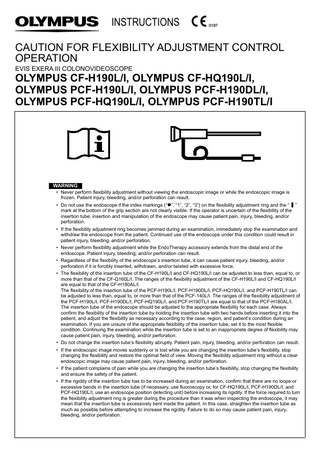OLYMPUS
CF and PCF-H190xx Series EVIS EXERA III COLONVIDEOSCOPE Caution Instructions Sept 2021
Caution Instructions
2 Pages

Preview
Page 1
INSTRUCTIONS CAUTION FOR FLEXIBILITY ADJUSTMENT CONTROL OPERATION EVIS EXERA III COLONOVIDEOSCOPE
OLYMPUS CF-H190L/I, OLYMPUS CF-HQ190L/I, OLYMPUS PCF-H190L/I, OLYMPUS PCF-H190DL/I, OLYMPUS PCF-HQ190L/I, OLYMPUS PCF-H190TL/I
WARNING • Never perform flexibility adjustment without viewing the endoscopic image or while the endoscopic image is frozen. Patient injury, bleeding, and/or perforation can result. • Do not use the endoscope if the index markings (“”, “1”, “2”, “3”) on the flexibility adjustment ring and the “ ” mark at the bottom of the grip section are not clearly visible. If the operator is uncertain of the flexibility of the insertion tube, insertion and manipulation of the endoscope may cause patient pain, injury, bleeding, and/or perforation. • If the flexibility adjustment ring becomes jammed during an examination, immediately stop the examination and withdraw the endoscope from the patient. Continued use of the endoscope under this condition could result in patient injury, bleeding, and/or perforation. • Never perform flexibility adjustment while the EndoTherapy accessory extends from the distal end of the endoscope. Patient injury, bleeding, and/or perforation can result. • Regardless of the flexibility of the endoscope’s insertion tube, it can cause patient injury, bleeding, and/or perforation if it is forcibly inserted, withdrawn, and/or twisted with excessive force. • The flexibility of the insertion tube of the CF-H190L/I and CF-HQ190L/I can be adjusted to less than, equal to, or more than that of the CF-Q160L/I. The ranges of the flexibility adjustment of the CF-H190L/I and CF-HQ190L/I are equal to that of the CF-H180AL/I. The flexibility of the insertion tube of the PCF-H190L/I, PCF-H190DL/I, PCF-HQ190L/I, and PCF-H190TL/I can be adjusted to less than, equal to, or more than that of the PCF-140L/I. The ranges of the flexibility adjustment of the PCF-H190L/I, PCF-H190DL/I, PCF-HQ190L/I, and PCF-H190TL/I are equal to that of the PCF-H180AL/I. The insertion tube of the endoscope should be adjusted to the appropriate flexibility for each case. Always confirm the flexibility of the insertion tube by holding the insertion tube with two hands before inserting it into the patient, and adjust the flexibility as necessary according to the case, region, and patient’s condition during an examination. If you are unsure of the appropriate flexibility of the insertion tube, set it to the most flexible condition. Continuing the examination while the insertion tube is set to an inappropriate degree of flexibility may cause patient pain, injury, bleeding, and/or perforation. • Do not change the insertion tube’s flexibility abruptly. Patient pain, injury, bleeding, and/or perforation can result. • If the endoscopic image moves suddenly or is lost while you are changing the insertion tube’s flexibility, stop changing the flexibility and restore the optimal field of view. Moving the flexibility adjustment ring without a clear endoscopic image may cause patient pain, injury, bleeding, and/or perforation. • If the patient complains of pain while you are changing the insertion tube’s flexibility, stop changing the flexibility and ensure the safety of the patient. • If the rigidity of the insertion tube has to be increased during an examination, confirm that there are no loops or excessive bends in the insertion tube (if necessary, use fluoroscopy or, for CF-HQ190L/I, PCF-H190DL/I, and PCF-HQ190L/I, use an endoscope position detecting unit) before increasing its rigidity. If the force required to turn the flexibility adjustment ring is greater during the procedure than it was when inspecting the endoscope, it may mean that the insertion tube is excessively bent inside the patient. In this case, straighten the insertion tube as much as possible before attempting to increase the rigidity. Failure to do so may cause patient pain, injury, bleeding, and/or perforation.
CAUTION • Do not attempt to bend the endoscope’s insertion tube with excessive force regardless of its flexibility. The insertion section may be damaged. • When reprocessing an endoscope that has the flexibility adjustment mechanism, make sure that the insertion tube is set to its most flexible condition (indicated by the “” mark on the flexibility adjustment ring). If the endoscope is reprocessed while the insertion tube is in a rigid condition, the endoscope may be damaged. • When storing an endoscope that has the flexibility adjustment mechanism, make sure that the insertion tube is set to the most flexible condition. Storing the endoscope when set to a rigid condition will increase the likelihood of damage. • Before putting the endoscope in the carrying case, always make sure that the insertion tube is set to the most flexible condition. Putting the endoscope in the carrying case while the insertion tube is rigid could damage the endoscope. Medical Devices Directive
This device complies with the requirements of Directive 93/42/EEC concerning medical devices. Classification: Class II a
Manufactured by 2951 Ishikawa-cho, Hachioji-shi, Tokyo 192-8507, Japan
Fax: (042)646-2429 Telephone: (042)642-2111
Distributed by (Premises/Goods delivery) Wendenstrasse 20, 20097 Hamburg, Germany (Letters) Postfach 10 49 08, 20034 Hamburg, Germany Fax: (040)23773-4656 Telephone: (040)23773-0
3500 Corporate Parkway, P.O. Box 610, Center Valley, PA 18034-0610, U.S.A. Fax: (484)896-7128 Telephone: (484)896-5000
5301 Blue Lagoon Drive, Suite 290 Miami, FL 33126-2097, U.S.A. Fax: (305)261-4421 Telephone: (305)266-2332
KeyMed House, Stock Road, Southend-on-Sea, Essex SS2 5QH, United Kingdom Fax: (01702)465677 Telephone: (01702)616333
A8F, Ping An International Financial Center, No. 1-3, Xinyuan South Road, Chaoyang District, Beijing, 100027 P.R.C. Fax: (86)10-5976-1299 Telephone: (86)10-5819-9000
(Seocho-dong, Majestar City Tower One), 2F & 3F, 12, Seocho-daero 38-gil, Seocho-gu, Seoul, 06655, Republic of Korea Fax: (02)6255-3210 Telephone: 1544-3200
Elektrozavodskaya str. 27 bld.8, 107023 Moscow, Russia Fax: (7)495-926-7072 Telephone: (7)495-926-7077
438B Alexandra Road #03-07/12, Alexandra Technopark Blk B, Singapore 119968 Fax: 6834-2438 Telephone: 6834-0010
3 Acacia Place, Notting Hill, VIC 3168, Australia Fax: (03)9543-1350 Telephone: (03)9265-5400
Date of Issue 20210901
RC7429 01
©2021 OLYMPUS MEDICAL SYSTEMS CORP. All rights reserved. Printed in Japan 20140528 *0000